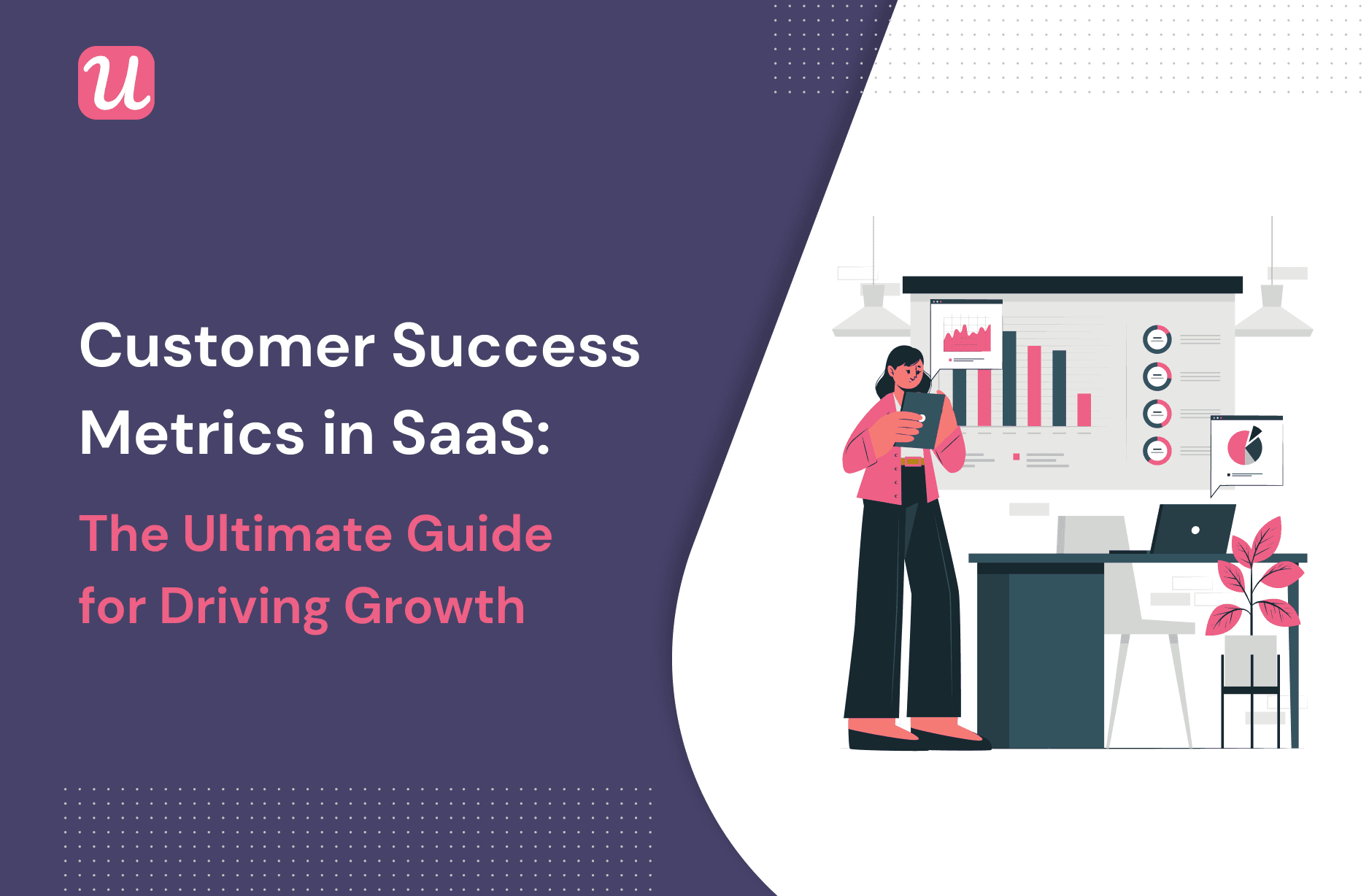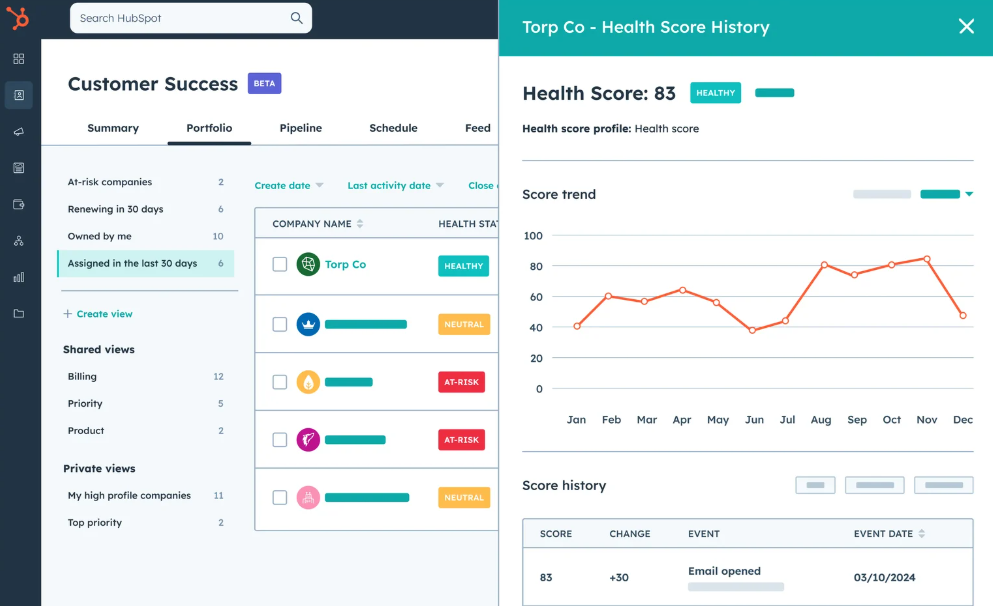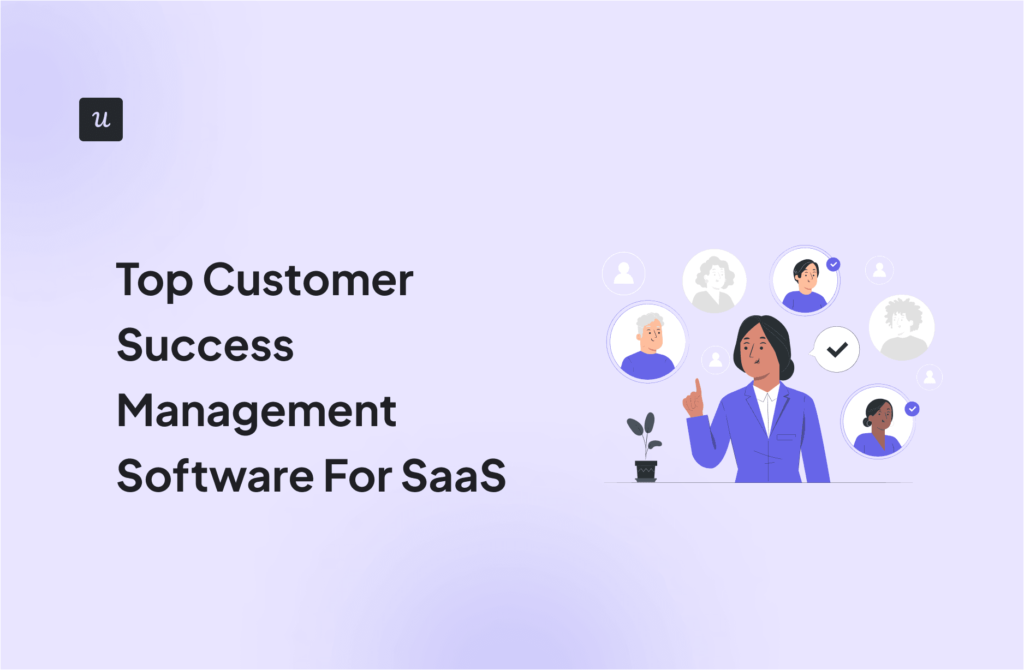
Customer Success Metrics in SaaS: The Ultimate Guide For Driving Growth
Try Userpilot Now
See Why 1,000+ Teams Choose Userpilot

What are the most important customer success metrics to track?
Customer success metrics measure the effectiveness of your strategies, level of customer satisfaction, and the likelihood to retain them over a long period.
To measure customer success, you need to keep track of metrics constantly. Tracking these metrics helps you stay on the right path and optimize your customer success strategy.
Besides, tracking metrics allow you to explore opportunities for expanding revenue to cross-sell and upsell.
The 10 most fundamental customer success metrics are:
- Customer Lifetime Value
- Customer Satisfaction Score
- Monthly Recurring Revenue
- Customer Churn Rate
- Customer Retention Rate
- Net Promoter Score
- Customer Stickiness
- Customer Engagement Score
- Customer Effort Score
- Customer Health Score
Customer Lifetime Value (LTV)
LTV stands for lifetime value. It refers to the average amount of money a business earns from a user over the time the user is a paying customer.
There are both simple and complex ways of calculating LTV. One way is to divide your Average Revenue per Account (ARPA) by your churn rate.

Why is the Customer Lifetime Value important?
Measuring LTV is especially important if your business has a large customer base and high transaction rates. Alternatively, with few enterprise-level clients, it’s probably better to focus more on acquiring more customers than increasing LTV.
Moreover, LTV increases the overall profitability of a SaaS business. Most of the profits in SaaS come from repeated subscriptions and not only a single transaction.
The longer you can retain existing customers, the more your revenue will grow, and the smaller your costs per user, the greater your LTV.
Customer Satisfaction Score (CSAT)
As the name suggests, the Customer Satisfaction Score measures customer satisfaction and experience with a particular product, feature, or team interaction.
Your pool of customers ultimately determines whether your product or service meets their expectations. So, customer satisfaction essentially equals customer success.
You can gather both quantitative and qualitative customer feedback by conducting short surveys and identifying the reasons behind the answers.
Qualitative methods include surveys, gathering insights from reviews, and sending direct emails to customers. On the other hand, quantitative methods include Customer Satisfaction Score (CSAT), Customer Engagement Score (CES), and Net Promoter Score (NPS).
Surveys are one of the most common means of collecting customer feedback.

With a simple quantitative question like the one in the image above, you can better perceive customer experiences with your product.
Why is Customer Satisfaction Score important?
Customer satisfaction brings in multiple benefits, including:
- Customer loyalty – as satisfied customers keep sticking around your product
- Word of mouth – as happy customers promote your product with the word of mouth and you get new customers from referrals
- Reduced costs – as keeping the existing customers is a lot cheaper than acquiring new ones.
Improving customer satisfaction is crucial since it makes your customers want to stick around, thus boosting your LTV.
Monthly Recurring Revenue (MRR)
Monthly Recurring Revenue refers to the amount of revenue a SaaS company can expect to earn from all its active subscriptions every month. It helps you predict the future cash flows and profitability of your business.
You can calculate MRR by multiplying average revenue per account (ARPU) with the number of existing accounts in a month.

Why is MRR important?
Monthly recurring revenue is one of the most powerful customer success metrics since it summarizes your entire revenue in a single metric, allowing you to get an overall idea of your company’s profitability.
You can track this metric and compare your MRR values over time to determine whether your users are achieving customer success with your product.
Customer Churn Rate (CCR)
Customer churn is a metric that shows the number of customers you lose each month. It measures how many paying users you had at the start of a period who have opted out of using your product in the next month.
When calculating CCR, you only need to consider the customers who stop renewing their subscriptions. CCR doesn’t take into account the customers who downgrade to freemium accounts. You should keep separate metrics for those since there’s a better chance of getting them back. You can use churn surveys to easily discover the reason behind your customer churn.
To find out the CCR, divide the number of churned customers during a particular period by the number of customers at the start of that period and multiply the result by 100.

Why is Customer Churn Rate important?
The churn rate could indicate a fault in your product. If a majority of your users keep churning, it suggests there’s something seriously wrong somewhere that’s preventing customers from getting value from your product.
This metric allows you to identify your weak points and initiate necessary customer success efforts to improve user experience and reduce CRR.
Moreover, you can identify users who are most likely to leave, segment them, and offer them help right before they take the final step. Using a tool like Userpilot, you can segment customers based on user identification, behavior, engagement, and customer events and create in-app experiences to improve customer experience and boost engagement.

Customer Retention Rate (CRR)
Customer retention is what you strive for to combat churn.
In SaaS, it’s is the combination of all the business activities performed to retain users and make existing customers more profitable.
Retention results from various user engagement strategies that translate into users reaching their Aha! Moments continually throughout their user journey. When they get continuous value from your product, it results in improved retention.
The customer retention rate is expressed as a percentage of customers retained over the total customer base for a given period. To obtain the figure, divide the number of paying customers at the end of the period by the number of paying customers at the start of that period, then multiply the result by 100.

Why is customer retention rate important?
It’s important to acquire new customers, but your SaaS business actually makes money when you retain more customers. The customers who stick around can even receive more value by buying add-ons, moving on to higher product tiers, or buying other products from your business.
Here are some interesting statistics to highlight the significance of customer retention in the world of SaaS.
- It costs 5%-25% less to retain existing customers than acquire new ones.
- A Totango study has found that between 75%-95% of company revenues come from renewals and upsells compared to only 5%-30% from the original sale.
Customer retention offers a plethora of benefits, such as:
- Less expensive than customer acquisition
- Increased customer lifetime value
- Improved brand loyalty and more recommendations
- Higher profits through account expansion opportunities via upsells, cross-sells, and add-ons
Net Promoter Score (NPS)
Net Promoter Score (NPS) measures customer loyalty by asking how likely users are to recommend your product to others.
It differs from other metrics like the CSAT score since it measures a user’s overall sentiment about your brand instead of their perception of a single purchase or team interaction.

NPS feedback is collected using in-app surveys like the one above. A Net Promoter Score survey consists of a simple question like:
“How likely are you to recommend our product to a friend or relative?”
Respondents are typically asked to answer on a scale from 0 to 10, with 0 referring to ‘Not Likely’ and 10 referring to ‘Extremely Likely’.
We would recommend you add a follow-up question to collect qualitative customer feedback. The second question should ask users to explain their reasons behind the score to identify specific pain points, areas of opportunity, and ways to improve user experience.

Subtract the percentage of detractors from the percentage of promoters to calculate the NPS metric. NPS scores can range anywhere between -100 and 100 depending on your promoter-detractor ratio.
NPS promoters are customers who give scores of 9-10. They are loyal customers who are most likely to be your brand advocates.
Passives give scores of 7-8 because they are indifferent. If you don’t address their pain points, they may switch to your competitor.
Then there are the detractors who give scores of 6 or less. They are unhappy customers you are at a high risk of losing. They may also cause further damage by sharing their bad experiences with others.
You can use a tool like Userpilot to track NPS survey answers and create automated responses in-app by targeting the right customer segments based on the survey results.
Why is NPS score important?
One of the key customer success metrics, the Net Promoter Score, provides valuable insights into how your users feel about your product.
When you realize what makes your users happy, you can use the insights to guide other users to the ‘desired behavior patterns’ in your onboarding flow. Any pain points in the follow-up data can help you find out issues in your product or service and rectify them. In addition, it can also contribute to product development. Thus, the NPS metric also lets you improve your customer retention rate.
Customer stickiness
Customer stickiness is a product usage metric through which you understand how often your users are returning to your app. It indicates whether or not your product is ‘sticking’ with your customers.
To measure customer stickiness, calculate the ratio of daily active users (DAU) to monthly active users (MAU).
Here, DAU is the number of active users who’re interacting with your product daily. MAU refers to the number of active users who’re interacting with your product each month.

You need to figure out the right level of DAU/MAU ratio for your product since it depends on the type of product.
Then, find users with the highest stickiness. To do this, compare several cohorts of users and find patterns. You can segment customers according to their in-app behavior for better understanding.
This can allow you to identify a correlation between a specific behavioral segment with greater usage, which in turn, might help you build a customer retention strategy.
Why is customer stickiness important?
Customer stickiness can indicate your product quality, which is very valuable in SaaS.
Low customer stickiness could indicate an increased churn rate. Your existing customers might not benefit from your product, which can lead to low customer engagement and possibly drop-offs. You can then address issues with your product or service accordingly to prevent customers from churning.
Furthermore, identifying user segments with more features or product usage can provide useful insights to help optimize your user acquisition strategy. Plus, you can streamline your whole onboarding process and in-app feature adoption campaigns.
Customer stickiness can also predict any potential for account expansion. If customers get repeated value from your product, they can boost your monthly recurring revenue through add-ons and upgrades.
Customer Engagement Score (CES)
Customer Engagement Score (CES) measures how engaged your free trial prospects and existing customers are with your product.
Every user gets an engagement score on their in-app activity and product usage. The more users with high engagement scores, the higher your customer engagement rate.
To calculate this metric, add the total event value of each customer, where the total event value is obtained by multiplying event importance by event occurrence.

You can use a tool like Userpilot for specific in-app user engagement and mobile surveys to gather customer feedback. It not only lets you track feature engagement without creating custom events but also allows you to launch in-app guiding experiences to stimulate product engagement. Ensure better tracking by simply tagging any UI features.

Feature tag in Userpilot and track. Get a demo and begin tracking in-app user engagement without any coding.
Why is Customer Engagement Score important?
CES allows you to customize your in-app experiences and messaging to certain user segments according to their needs.
For instance, a low CES during the trial run might point to specific accounts so that you can test varying approaches to boost engagement with key product features to increase the trial to paid conversion rate.
A sudden fall in engagement can help you proactively reach out to those customers and decrease churn.
Moreover, CES lets you discover happy and engaged users. They are more likely to expand your MRR by upgrading their subscriptions or purchasing add-ons if you approach them in the right context at the right time.
Because CES is measured per user, you can take relevant, personalized actions to decrease churn, trigger brand loyalty, and increase retention.
Customer Effort Score (CES)
Customer Effort Score measures the amount of effort a customer puts into interacting with your business. These interactions include requesting features, resolving issues, or simply asking questions.
Its value ranges between 0 and 100 and measures the percentage of surveyed customers who found it easy to interact with you.
Customer Effort Score is the number of ‘agree’ responses (with ratings of 5, 6, or 7) divided by the total number of responses, multiplied by 100.

Email and in-app are the most commonly used channels for sending a CES survey.
Why is Customer Effort Score important?
Customer Effort Score is one of the fairly new customer success metrics. Over the years, it has been found to bring in more and more benefits.
- Less friction and improved customer experience
- Evaluate and optimize the customer experience across several touchpoints
- Proactively improve loyalty and limit negative word of mouth
Less friction occurs when you identify where your customers need help and act on it to resolve their issues. As a result, the overall customer experience improves, making it easier for them to advance from one stage of the user lifecycle to the next.
Customer Health Score (CHS)
Customer Health Score (CHS) is used to understand how likely your customers are to stay consistent, grow, or churn. Customer success managers can use it to predict how their business’s relationship with a user might change over time.
To calculate the CHS, first, measure the key action of each user by multiplying the action impact on a scale of 1 to 10 by the action frequency during the set period.

Then, simply add the total action value of each customer to get the customer health score.

This is how you interpret the scores:
- Negative score = very sick (at high risk of churn)
- Score between 1-40 = sick
- Score between 41-70 = somewhat healthy
- Score between 71-100 = very healthy
- Score more than 100 = thriving (power users who constantly engage with your product and are likely to upgrade).
Why is Customer Health Score important?
Customer health scoring enables you to identify power users, unearth success and failure patterns, discover potential churning customers beforehand, and identify opportunities for expanding accounts.
Additionally, you can create a CHS to track the health of freemium accounts to figure out the right moment to approach them and offer an upgrade.
To find success and failure patterns, check the user data of both unhealthy and healthy customers. Then you can repeat the success for new customers using in-app guidance and make improvements to your product by removing frictions that cause failure.
Now, let’s take a look at the best tools that drive customer success.
The best tools to drive customer success
Userpilot
Although Userpilot primarily focuses on onboarding customers, it’s still one of the best tools for achieving customer success, especially in early-stage SaaS companies. It helps customer success teams to track how users achieve goal completion by using your product.
Moreover, Userpilot’s analytics allows you to create multiple customer segments using advanced user segmentation capabilities. It lets you see how different segments engage with your product, making it a necessary onboarding tool for personalized onboarding.
The best part is that your customer success team is then able to enhance your in-app messaging. This, in turn, helps boost engagement and eventually retention, which increases your customer lifetime value.
Your CS team won’t need to depend on your busy Dev team to carry out the messaging since Userpilot enables them to do so without coding. – all they’ll need is a customer success tool.
Onboard and engage mobile app users by creating personalized messaging, push notifications, and surveys with Userpilot.
Additionally, Userpilot lets you collect customer feedback using NPS surveys. So, your CS team gets more data to analyze and take actions to improve user experience.

Other tools for driving customer success include:
HubSpot
HubSpot’s dedicated CSM software makes it super easy to monitor customer health scores. You can grab quick overviews of all your customers’ likelihood to churn, visualize health score trends, and get extra context about each specific customer through its built-in Smart CRM.

Hotjar
Hotjar provides heatmaps and session recordings, plus in-app survey widgets. You can see how users are really using your website, collect feedback and understand your users behavior.

Zendesk
Zendesk is software for customer service, sales, and other customer interactions. It is one of the best tools for logging and handling complex support tickets to improve customer success rates.

Custify
Custify is a customer behavior tracking tool. You can look at your customer’s behavior, product usage, customer health score data, and journey for a holistic view of the user experience.

Wrapping it up
The customer success metrics mentioned above hit key touchpoints in the user journey and help increase the average customer lifespan. You need to constantly track them to have a clear understanding of how healthy your business is.
To get better insights into how your customer behavior, gather feedback in a context way, reach out to users to improve engagement, and drive customer success. Then, get a Userpilot demo and get started right away!







